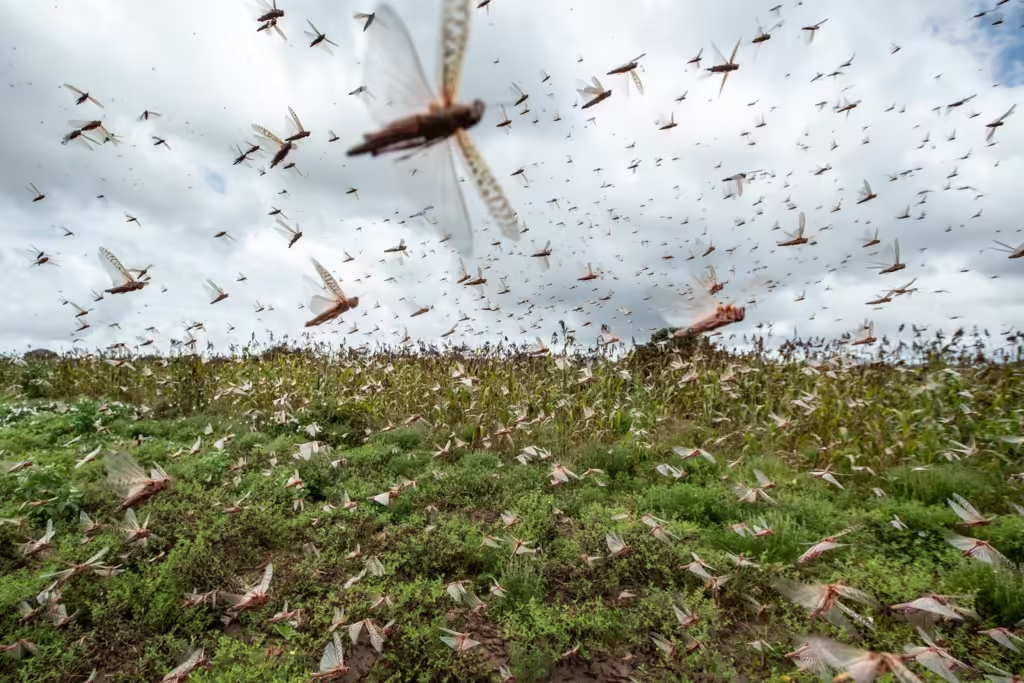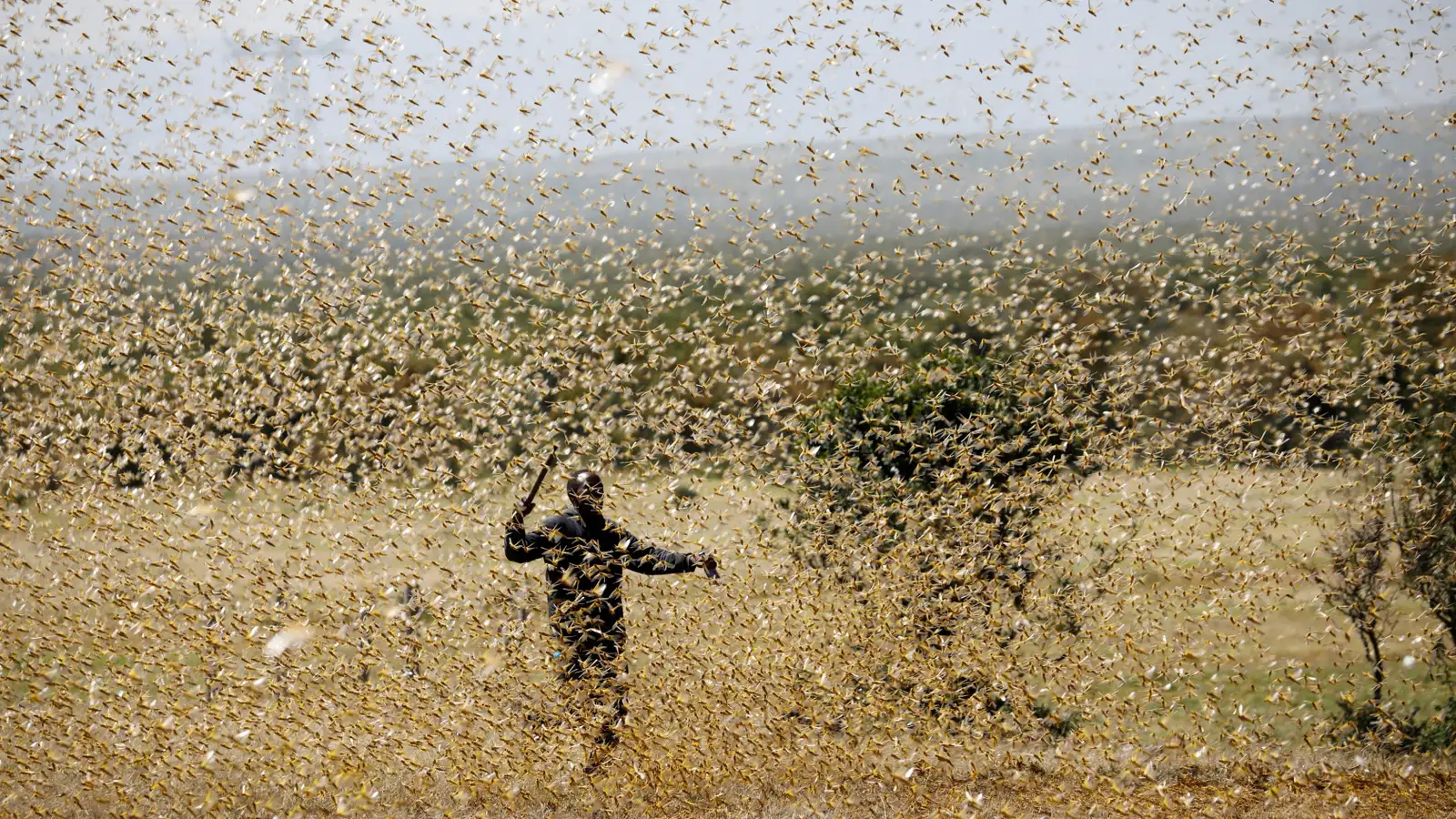Food & Climate
Winds and rainfall patterns have facilitated desert locusts movement in Northwest Africa that raised concern amid spring breeding season, and the transboundary insect threatens thousands of tons of food.
So, the Food and Agriculture Organization of the United Nations (Winds and rainfall patterns) is urging countries in Northwest Africa to enhance monitoring and initiate early control measures as adult desert locust groups and small swarms – originating from the Sahel – moved into southern Sahara in the Western Region of the desert locust distribution area.
Locust activity intensified from late February through March, with adult groups and small swarms arriving in central Algeria, western Libya, and southern Tunisia. Due to favorable ecological conditions, the current spring breeding season has witnessed significantly larger infestations than usual.
Winds and rainfall patterns have facilitated northward movement of desert locusts from southern Algeria, northern Mali, Niger and Chad. In these Sahelian regions, small groups were breeding from August until early March, according to a statement that “Food & Climate” platform received today from FAO.
The influx of populations into Northwest Africa – particularly in the north and south of the Hoggar Mountains in Algeria and Fezzan in southwest Libya – has prompted FAO to classify the situation in the Western Region as caution, requiring increased vigilance.
Increasing the risk to crops and pastureland
“Surveys and control operations are particularly urgent in locations where winter and early spring rains have created suitable breeding conditions,” said Cyril Piou, Locust Monitoring and Forecasting Officer. “FAO forecasts since January have said that hatching and band formation would start this month in affected areas. If left unchecked, these bands could develop into small swarms from May to June, increasing the risk to crops and pastureland.”

FAO recommends conducting intensive ground surveys across key areas where locust breeding is likely to occur – spanning from south of the Atlas Mountains in Morocco to the Sahara in Algeria and extending to southern Tunisia and western Libya. These areas have received sufficient rainfall to support vegetation growth, creating favorable conditions for locust development.
The desert locust remains one of the world’s most destructive migratory pests. A single swarm can cover one to several hundreds of square kilometers. Just a single square kilometer of swarm can contain up to 80 million adults, with the capacity to consume the same amount of food in one day as 35,000 people. Early detection and rapid response are critical to preventing a wider crisis.
Desert locust invasions
Transboundary pests pose a significant threat to agricultural production and household incomes, and desert locust invasions are among the most devastating. Despite ongoing control efforts, such as monitoring and chemical interventions, the rapid spread of locusts into their non-traditional breeding areas and limited preparedness highlight the need for integrated desert locust management, according to a recent study by the Department of Agricultural Economics at the University of Nairobi, Kenya.
Transboundary pests (migratory pests that invade and affect large geographic areas), including the desert locust and the fall armyworm, negatively impact agro-pastoral resources and livelihoods worldwide, causing an estimated $65.58 billion annually in production losses and control costs, according to the study. Recent trends indicate that Sub-Saharan Africa and South Asia have the highest Global Hunger Index score of 27. This compares favorably with the second-highest Global Hunger Index score in Western Asia and North Africa (11.9), Latin America and the Caribbean (8.6), East and Southeast Asia (8.3), and Europe and Central Asia (6.1).
The main drivers of rising food insecurity include climate variability, conflict, and economic downturn. In this context, climate variability is linked to the unpredictable and devastating impacts of desert locust invasions. Therefore, it is essential to effectively manage the severe consequences of these pests on farms and livelihoods.
For example, the most recent desert locust invasion in 2019-2020 was triggered by heavy rains in the locust breeding areas of the Arabian Peninsula, moving through Yemen, Eritrea, and Somalia. Strong winds and heavy rains contributed to increased locust breeding, pushing adult desert locusts into Ethiopia and Kenya in late 2019, and then to Uganda, Tanzania, and South Sudan. These invasions impacted millions of livelihoods in South Asia and East Africa. For example, agricultural losses in Pakistan were estimated at $1.2 billion.
The desert locust invasion in Ethiopia caused the loss of an estimated 197,160 hectares of cropland, 1.35 million hectares of pasture, and an estimated loss of 356,290 metric tons of cereals, affecting approximately 806,400 farming households, according to FAO in 2020.
In Kenya, an estimated 30,210 hectares of cropland and 579,790 hectares of pasture were affected by the desert locust invasion. Furthermore, in 2020, the United States Agency for International Development estimated the economic losses incurred by the desert locust infestation in East Africa at $8.5 billion.

Desert locust control efforts have relied on a multi-pronged strategy led by the FAO in collaboration with other multilateral partners. However, the heavy reliance on chemical treatments has raised concerns about potential adverse effects on the environment and human health.
Another alternative method of locust control involves the use of biopesticides, such as Metarhizium. Although biopesticides are less harmful, their reaction time is slow and their range is narrow, making their development costly, according to the study published in “Frontier“.

